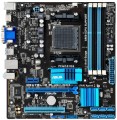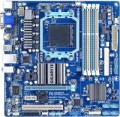VRM heatsink
The design of the motherboard has a separate heatsink for VRM.
VRM is a voltage regulation module through which power from a computer power supply is supplied to the processor. This module steps down the standard power supply voltage (+5V or +12V) to a lower value required by the processor (usually just over 1V). At high loads, the voltage regulator can get very hot, and without a specialized cooling system, the matter can end with overheating and even burnout of parts. The VRM heatsink reduces the likelihood of such situations; it can be useful for any CPU, and highly desirable if the board is planned to be used with a powerful high-end processor (especially overclocked).
Size (HxW)
Motherboard dimensions in height and width. It is assumed that the traditional placement of motherboards is vertical, so in this case one of the dimensions is called not the length, but the height.
Motherboard sizes are largely determined by their form factors (see above), however, the size of a particular motherboard may differ slightly from the standard adopted for this form factor. In addition, it is usually easier to clarify the dimensions according to the characteristics of a particular motherboard than to look for or remember general information on the form factor. Therefore, size data can be given even for models that fully comply with the standard.
The third dimension — thickness — is considered less important for a number of reasons, so it is often omitted.
BIOS
The type of BIOS installed on the motherboard. Note that only “classic” BIOSes are taken into account here — from Ami, from Award and from Intel; a more advanced UEFI BIOS has been moved to a separate item (see below).
The BIOS is the basic input/output system, the motherboard's own software firmware stored in its permanent memory; it allows all the hardware components of the system to interact with each other, even if the computer does not have an OS installed. In other words, it is the “bios” that controls the computer from the moment it is turned on until the operating system boots. This firmware also includes a set of tools for changing the basic settings.
Speaking about specific varieties, it is worth saying that the mentioned "classic" firmware do not have fundamental differences between themselves; in addition, the set of features is largely determined not by the type of BIOS, but by the model of the motherboard. Therefore, the type of BIOS is not a key choice; even for professionals and enthusiasts, it rarely turns out to be fundamental.
DualBIOS
Motherboard support for DualBIOS technology.
Crashes and errors in the BIOS (see BIOS) are one of the most serious problems that can occur with a modern PC — they not only make the computer unusable, but also very difficult to fix.
DualBIOS technology is designed to make it easier to deal with such problems. Motherboards made using this technology have two chips for writing the BIOS: the first chip contains the main BIOS version, which is used to boot the system in normal mode, the second one contains a backup copy of the BIOS in the original (factory) configuration. The backup chip comes into operation if an error is detected in the main BIOS: if an error is detected in the programme code, it is restored to the original factory version, but if there was a hardware failure, the backup chip takes control of the system, replacing the main one. This allows you to keep your system up and running even in the event of serious BIOS problems without resorting to complex recovery procedures.
UEFI BIOS
The presence of
UEFI BIOS firmware on the motherboard.
Such firmware is usually combined with one of the classic "bios" (see BIOS). In fact, it is an additional add-on that expands the BIOS and makes it more convenient to manage. In some ways, UEFI approaches a full-fledged operating system: it has a convenient and understandable graphical interface even for a non-specialist, supports mouse control, is equipped with an extensive set of tools, and in some versions there is even the ability to access the Internet. In addition, this firmware takes into account all the features of modern computer hardware — including those that have appeared recently and are not covered in earlier, traditional BIOSes.
Max. clock frequency
The maximum RAM clock speed supported by the motherboard. The actual clock frequency of the installed RAM modules should not exceed this indicator — otherwise, malfunctions are possible, and the capabilities of the “RAM” cannot be used to the fullest.
For modern PCs, a RAM frequency of
1500 – 2000 MHz or
less is considered very low,
2000 – 2500 MHz is modest,
2500 – 3000 MHz is average,
3000 – 3500 MHz is above average, and the most advanced boards can support frequencies of
3500 – 4000 MHz and even
more than 4000 MHz.
Integrated graphics model
The name of the integrated graphics card (see above) installed in the motherboard. Knowing the name of the graphics module, you can, if necessary, easily find detailed information about it — full specifications, tests, reviews, etc.
Hybrid mode
Hybrid mode support is only found on motherboards equipped with native graphics cards (see Integrated graphics card). When an additional separate graphics card is installed on such a board, the system can automatically optimize the operation of video adapters depending on the current tasks: use a relatively low-power, but economical and silent motherboard's own video chip for simple actions (working with documents, web surfing) and additionally connect a powerful external graphics card to work with resource-intensive applications (games, HD video, 3D rendering). Purchasing a motherboard that supports hybrid mode makes sense only if you plan to install a separate graphics card on it. In this case, it is worthwhile to separately clarify the compatibility of this graphics card and the motherboard.
Sound (channels)
The most advanced audio format that the motherboard audio chip is capable of outputting to an external audio system. At the moment, almost all motherboards with audio chips support standard 2.0 stereo sound, and the most advanced format can be as follows:
— 4. The specific sound layout for the four channels may be different, but anyway, this option is two classic stereo channels, supplemented by two more — for example, centre and rear, or a pair of rear (left and right). This allows you to expand the sound stage and achieve greater volume than in classic stereo, while maintaining the low cost of the sound cards themselves. However, this option is rare, mainly in mini-STX boards (see "Form factor").
— 5.1. Six-channel sound: two front, centre and two rear channels, plus a subwoofer for bass and extra bass. Allows you to reproduce a fully surround sound, which is perceived by the listener not only in front, but also behind him. One of the most popular multi-channel audio formats today.
— 7.1. The development of the idea of surround sound, laid down by the 5.1 format. In addition to the standard six-channel configuration (centre, front pair, rear pair and subwoofer), it provides two more speakers. The place of their installation may be different, depending on the specific eight-channel sound scheme used: above the front or rear pair, in the form of a centre-rear pair, on the sides of the listener, etc. Anyway, eight-channel circuits allow more...accurate sound direction reproduction.
— 9.1. The most advanced version of acoustics found in motherboards today. Similar to 7.1, this standard includes 6 channels according to the 5.1 scheme plus additional speakers — only in this case there are four of them, which gives even more opportunities to expand the surround sound.

